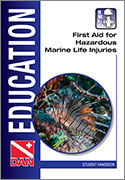DAN - First Aid for Hazardous Marine Life Injuries
This course represents entry-level training designed to educate the general diving (and qualified non-diving) public to identify hazardous marine life, to recognize possible injuries caused by hazardous marine life, to provide first aid for hazardous marine life injuries and to avoid hazardous marine life injuries. Prerequisite is have current First Aid.
Divers Alert Network is Your Dive Safety Association
DAN is Divers Alert Network, the diving industry's largest association (non-profit) dedicated to scuba diving safety. Serving scuba divers for more than 30 years, DAN provides emergency assistance, medical information resources, educational opportunities and more.
Half day (4hr) practical dry course for divers with First Aid training.
Course Objective
The objectives of this course are to train and educate the general diving public and interested non-divers in the first aid techniques for a suspected hazardous marine life injury. In addition, this course will introduce divers to the identification of potentially hazardous marine life and how to avoid hazardous marine life injuries. This program also provides an excellent opportunity for experienced divers and instructors to continue their education.
Learning Objectives
- At the end of this program, participants will be able to:
- Identify the four types of hazardous marine life injuries.
- Name at least five venomous marine animals.
- List five common warning signs of an envenomation.
- Describe the appropriate first aid procedure for managing a venomous marine animal injury.
- Name at least three aquatic animals that may bite a diver.
- List two common warning signs of marine animal bite.
- Describe the appropriate first aid procedure for managing a bite from a marine animal.
- Name at least three marine animals that may cause irritations to the diver.
- List at least four common warning signs of irritations.
- Describe the appropriate first aid procedure for managing brushes with aquatic life.
- Identify two common types of seafood poisonings.
- Name at least three types of fish that can cause seafood poisoning.
- List three common warning signs of seafood poisoning.
- State the reason why evaluation by a medical professional is necessary when seafood poisoning is suspected.
- Describe the appropriate first aid procedures for managing suspected seafood poisoning.
- Perform a scene safety assessment.
- List the steps in performing a scene safety assessment.
- Assess the Airway, Breathing and Circulation (ABCs) of an injured diver.
- Demonstrate a caring attitude towards a diver who becomes ill or injured.
- Establish and maintain the Airway and Breathing (perform Rescue Breathing) for an injured diver.
- Describe the importance of the use of supplemental oxygen as a first aid measure for injured divers.
- Demonstrate the techniques for controlling bleeding including direct pressure, elevation and the use of pressure dressings and pressure points.
- Locate and demonstrate the use of pressure points to control external bleeding.
- Apply dressings and bandages to manage wounds caused by hazardous marine life.
- Demonstrate an ongoing assessment and manage shock.
- Demonstrate the pressure immobilisation technique.
- List the components of an Emergency Assistance Plan.
- Describe at least five techniques or guidelines that minimize the risk of injury from marine animals.
The nature and scope of this course is limited to training divers and interested non-divers such as boat captains, water enthusiasts and non-diving family members to identify potential hazardous marine life; to provide first aid for a hazardous marine animal injury; and to prevent injuries caused by hazardous marine life. This course does not provide training for cardiopulmonary resuscitation (CPR) or scuba diving rescue. The training exercises of this course presuppose that the ill or injured diver has already been brought to shore or is aboard the boat.
This is an ideal course for all divers and especially just before you go on holiday as you will encounter new and varied marine life.
Where can I go from here?
- Join the C-Life Dive Club if you haven't already to get cheaper kit hire and cheaper courses.
- Hire our full Drysuit and Scuba kit including Drysuit, undersuit, hood, gloves, & Scuba worth over £1,000
- After that if you complete the Rescue Diver Course and five Specialty Diver Courses you can apply for the TOP Non Professional Rating of Master Scuba Diver certification.
Other Courses related to this Course
First Aid for Hazardous Marine Life Injuries,
Emergency First Response, Drysuit Diver, Boat Diver, Peak Performance Buoyancy, Night Diver, Wreck Diver, Enriched Air Diver, DPV, Technical Courses such as Advanced Nitrox
Dates
On demand CALL
Price
£150
Manual
.png?etag=%226c23-54e36995%22&sourceContentType=image%2Fpng&ignoreAspectRatio&resize=110%2B96)




